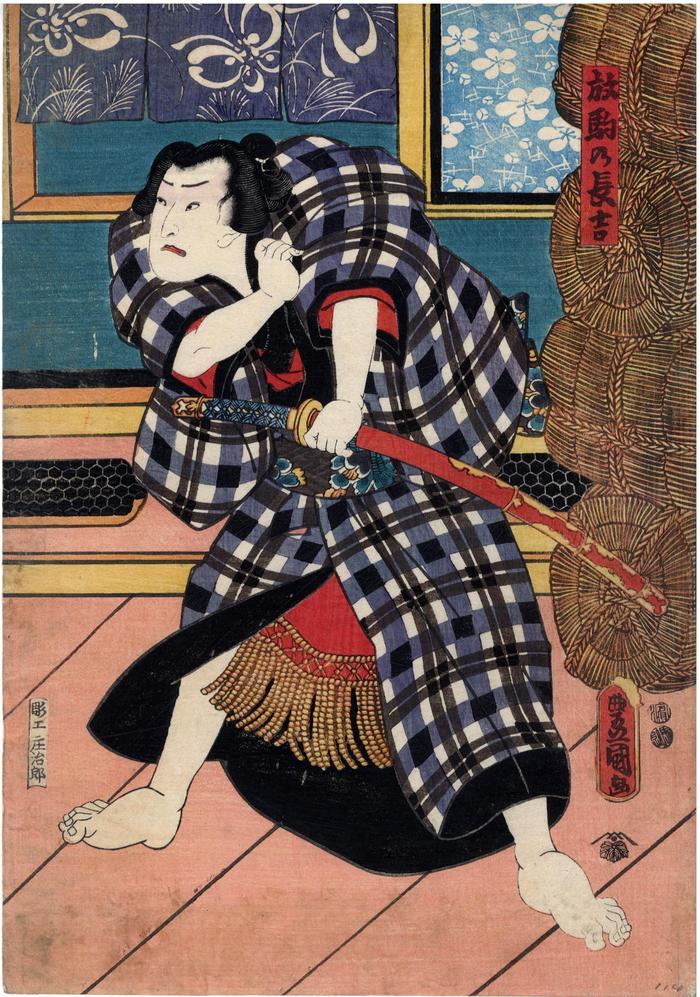Utagawa Kunisada (歌川国貞) / Toyokuni III (三代豊国) (artist 1786 – 01/12/1865)
Arashi Rikan III (嵐璃寛) as Hanaregoma no Chōkichi (放駒乃長吉) - right panel of a triptych
1852
9.8 in x 14.1 in (Overall dimensions) Japanese color woodblock print
Signed in a toshidama frame: Toyokuni ga (豊国画)
Publisher: Tsutaya Kichizō (Marks 556 - 03-004)
Carver: Hori Shōji
Censors: Hama and Magome
Museum of Fine Arts, Boston (complete triptych)
Waseda University - right panel
Waseda University - center panel
Waseda University - left panel
Cooper Hewitt This print in the Lyon Collection is the right sheet of a triptych representing a scene from the play Futatsu chōchō kuruwa nikki ('Diary of Two Butterflies in the Pleasure Quarters'). The figure in the center is Ichikawa Kuzō II (二代目市川九蔵) as Chōkichi's older sister (ane) Oseki (長吉姉お関), and on the left is Ichikawa Danjūrō VIII (八代目市川団十郎) as Nuregami Chōgorō (濡髪長五郎).
****
The curatorial files accompanying a Toyokun I diptych in the collection of Arizona State University state:
"Play: Futatsu chōchō kuruwa nikki (Two butterflies, the pleasure-quarter diary). This play was originally written for the puppet theater. It was performed as a Kabuki play for the first time in 1749. Story: Since the death of their parents, a young woman, Oseki, has been taking care of her younger brother, Chōkichi. She runs a rice store and wishes her brother would help more and be in trouble less. Chōkichi has an enemy, Chōgorō, who arrives at the rice shop after Oseki leaves to attend a religious meeting. This scene shows Chōkichi and Chōgorō fighting in the rice shop over the rice bundles. But soon strangers come into the shop claiming Chōkichi has stolen from them, temporarily stopping the fight. Oseki returns, and though Chōkichi claims he is innocent, she finds the stolen goods in the store. Oseki is disappointed in her brother. Since he cannot prove his innocence, he is about to commit suicide when Chōgorō stops him. Chōgorō says Chōkichi should be good to his sister. They both agree to stop fighting and Chōkichi agrees to behave better. Oseki has been listening from another room and returns, revealing that the thefts were staged to force Chōkichi to be a better brother. "
Another summary
An article by Rei Sasaguchi in the January 15, 2003 in the Japan Times it says: "The Tokyo National Theater, meanwhile, celebrates the new year by offering “Futatsu Chocho Kuruwa Nikki (The Two Chos),” performed in its entirety by an excellent cast. Adapted from a nine-act bunraku play written by Takeda Izumo and collaborators in 1749, this work tells the tale of two sumo wrestlers popular in downtown Osaka — Nuregami Chogoro and Hanaregoma Chokichi — and their quarrel after Chogoro intentionally loses an important match against amateur opponent Chokichi.
The two are reconciled after their argument and pledge brotherhood. Matters turn tragic, though, when Chogoro inadvertently kills two samurai and flees to his mother, Oko, who lives in a village by the Yodo River. Oko first urges her son to escape, but changes her mind, resolving to let her stepson, Jujibei, arrest Chogoro. The sympathetic Jujibei, however, helps Chogoro flee by cutting the rope with which Oko has bound her son to a skylight.
For the last 100 years this final act has often been staged independently under the title of “Hikimado (Skylight).” It is a beautifully constructed drama in its own right, focusing on Oko, torn between her love for her son and her sense of duty. Nakamura Kichinojo, 70, gives an extraordinary performance as Oko, one of the noblest characters of the bunraku and kabuki stages, and his presence seems to enhance the performances of Nakamura Kichiemon as Chogoro, Nakamura Tomijuro as Jujibei, and Nakamura Tokizo as Jujibei’s attractive wife Ohaya."
The Butterfly Connection
"The Japanese title of the play, Futatsu chōchō, meaning 'Two Butterflies', is a pun on the names of the two main characters, sumo wrestlers, who have chō in their names." In a footnote to this comment it is noted that butterflies represent souls of the living and the dead and that the appearance of butterflies often is an omen of coming death.
Source and quote: Heroes of the Kabuki Stage by Arendie and Henk Herwig, pp. 197 and 201.
This explains the white butterfly design on the purple fabric seen on the noren hanging behind the figure shown in this print.
****
There are at least four other items in the Lyon Collection related to this play.
actor prints (yakusha-e - 役者絵) (genre)
Tsutaya Kichizō (蔦屋吉蔵) (publisher)
Arashi Rikan III (三代目嵐璃寛: 8/1843-4/1863) (actor)
sumō (相撲) (genre)
